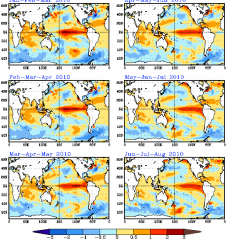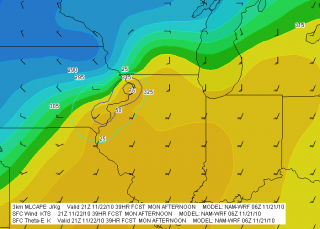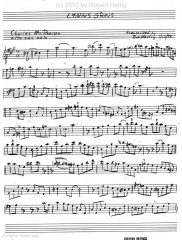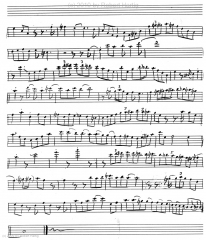Happy New Year, everyone! Welcome to a brand new decade.
With multiple possibilities for my first blog post in the year 2010, I find myself contemplating a recent thread on Stormtrack, and, in the light of it, reminiscing about my own development as a storm chaser.
The thread started with a newbie chaser asking forum members’ opinions about what constitutes a “veteran chaser.” The guy took a bit of a bashing initially, but to me his question seemed innocent, reflecting honest curiosity rather than a preoccupation with labels or a need to earn some sort of merit badge, and it made for an interesting discussion.
And, as I’ve said, it got me to reflecting on my personal path. One by one, the chase seasons have connected to each other like boxcars on a train. It seems incredible to think that 2010 will mark my fourteenth year chasing storms. If years alone were what it took to make a person a veteran chaser, then I might qualify.
But years alone do not a veteran make–at least, not in my opinion. A veteran road warrior, yes; a veteran storm chaser, no. There are plenty of people who have been chasing a shorter time than me, but who have acquired far more skill and experience. As for me, I’m just a slow but happy learner who’s too low-key to mess with light bars.
However, the span of time I’ve been chasing has allowed me some formative experiences I probably wouldn’t have had if I had started more recently. Today, it seems like the average neophyte steps into the field equipped, if not with knowledge, at least with a laptop, GR3, GPS, and an aircard. He or she has a technological edge that didn’t exist, or that barely existed, back when I was getting started.
I now realize that the simplicity and constraints of those first, low-tech years have left me with a gift of memories. I treasure those thousands of miles I traveled–sometimes by myself, sometimes with Bill and/or Tom Oosterbaan–equipped with nothing more than a weather radio, a portable black-and-white TV set, high hopes, and an eye on the sky.
Radar? I stopped at local libraries and airports and got my fix. I had no idea how long a radar image would be good for, how much difference four-and-a-half minutes and a single scan could make. Today I just shake my head and think, no wonder I never saw any tornadoes. It’s a wonder I managed to see a stinkin’ cloud.
As for forecasting, that consisted of looking at SPC outlooks and then steering for the middle of a moderate or high risk area. At some point, though, I discovered my first link to a site for forecasting models, and an interesting–and daunting–new window opened up. Suddenly, here was a bewildering suite of data–surface dewpoints, BRN shear, CAPE, lifted indices, helicity, 300 mb winds…alchemy, pure alchemy, and in a variety of flavors at that. GFS. ETA. RUC. Hoo boy, talk about dumping a load on my head!
Around that same time, I attended my first severe weather conference at College of DuPage. As I recall, Chuck Doswell conducted a workshop on hand analysis and Eric Rasmussen shared some findings from the first Project Vortex. By then, I knew just enough acronyms and concepts to make sense out of some of what was getting thrown at me. Much of the value lay simply in being exposed to the actual stuff of operational forecasting and severe weather research. There’s something to be said for sheer exposure; even if a body grasps just a fraction of the concepts he encounters, what matters is, it’s a start. I left that conference, and the one that followed it a year or two later, equipped with a little more awareness and a little less ignorance than I had coming in.
My first successful tornado intercept occurred in my first season as a chaser, in 1996, in my home state of Michigan. A wall cloud formed directly south of my workplace, and I left work early to chase it sixty miles to where it put down a beautiful tube out in the open countryside near St. Johns. The storm was a classic supercell, as nice as anything I’ve seen out on the Great Plains, though at the time I had no ground for comparison and knew nothing about storm modes or morphology.
It would be another ten years before I witnessed my next tornado in 2006, as Bill and I tracked the historic Six State Supercell from west of Columbia, Missouri, all the way back to Michigan. Prior to that, I had roamed my state and neighboring Indiana, and pounded the flatlands of Illinois, with just a handful of wall clouds and a growing awareness of storm structure to show for it. The year 2005 was my first excursion across the Mississippi and my first experience watching storms explode along the dryline in central Kansas.
But 2006 was the year when things finally started coming together for me, and I think that Bill–my consistent chase partner for all these years–would say the same, since our personal learning curves have been closely tied together. By then we were using Bill’s business laptop and had access to NOAA radar. I had just discovered the significance of velocity couplets, although, not yet understanding the benefit of using storm relative velocity over base level velocity, I was using the latter. Again, it was a start, and the base level gave us enough data to keep us from very likely getting blown off the road by the Springfield, Illinois, tornado as Bill and I chased the Six State Supercell.
A month later, we intercepted tornadoes in Iowa, including another large, night-time tornado that did F2 damage in Iowa City.
That same year, I acquired my own laptop, and the following spring I added GR3, and from there on, my learning and experience curve began to snowball. Today, as I look at where I started and where I’m now at, I realize that I’ve learned a few things. I’ve gained another great chasing partner in my buddy Kurt Hulst. I’m making my own forecasts with increasing knowledge and accuracy. I haven’t seen a lot of tornadoes, but I’ve seen my share, and I trust that, by God’s grace, I’ll see more, as well as endure more busts and make more idiotic choices that cost me storms I could have had.
So, getting back to the question of what makes a veteran chaser, I’m firsthand proof that there’s more to it than just the number of years a person has been chasing storms. In my opinion, there are actually three components to being a veteran storm chaser:
1. Really, really knowing what the heck you’re doing,
2. Many years of doing it, and
3. Lots of successes and lots of failures to show for it.
I probably fulfill the second criterion. As for the other two, well…I’ve got a ways to go, but I’m working on them. Give me another ten years and maybe the hat will fit. It really doesn’t matter, though. As a general rule, chasers who are worth their salt don’t give a flip about labels. They’re driven by storms, not status. Certain names are indeed revered–icons such as Tim Marshal, David Hoadley, Roger Edwards, and Gene Moore. As for the rest of us mortals, I think that those who’ve been at it a for a while respect others who have paid their dues. We know the names, if not the actual faces, and recognize the shared passion and personal investment behind those names. The countless miles traveled. The commitment to learning and growth.
Above all, the love for the storms that keeps us dreaming all through the winter, and that, in the spring, calls us once again toward the open skies, the tumbled clouds, and the hope and promise of the Plains.
[XUB6K3AQNFKD]





